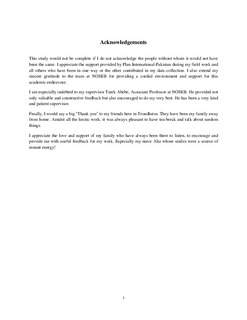What's so good in my life? Children's Perspectives and Understanding of Well-being in an Urban Slum: A Case study in Islamabad, Pakistan
Master thesis
Permanent lenke
http://hdl.handle.net/11250/269102Utgivelsesdato
2013Metadata
Vis full innførselSamlinger
Sammendrag
This study aimed to explore the perspectives of children about their well-being through participatory research in the context of an urban slum area in Islamabad, the capital city of Islamabad. Eighteen children: ten girls and eight boys participated in this study and generated a rich data. During this research I used qualitative research methods which include informal conversations, guided tours, group discussions and interviews and observation. These methods were selected in consultation with the children that participated in the study. This highlights the essence of childhood studies which acknowledges children as active agents and beings whose lived experiences are worth studying. Also, they should be included in the research as participants rather than only objects or subjects of the research. The major theoretical perspectives which provided a starting point for this study are: sociology of childhood, child well-being indicators and capability theory. These three perspectives intertwined really well providing a broad knowledge base to build my study upon by highlighting the importance of viewing children as a structure in society which needs to be studied on its own, especially their quality of life and looking at it from the perspective of capabilities and not just deficiencies.
The children in this study not only listed money, education and family and friends for a good life but also included freedom, respect, self esteem and good environment. However, the way children in this study described those indicators may differ from the dominant view prevailing in the society. For example, while money was considered important for a good life excess of it was considered bad. Also, children had high moral standards about the way this money was earned. It was also worth to note the ways boys and girls defined a good life. There were some commonalities between boys’ and girls’ indicators of well-being but they did not describe those indicators in the same way. This highlights the need of child well-being to be studied in the social and cultural context in which the children live. The children in this study also contested the mainstream definition of slums and did not consider their area as a slum.
Until now there have been very few studies in the field of child well-being which involve them as participants. This is especially important for policy makers and others working with and for children to find out what children actually say about their lived experiences, only then we can be able to create a positive difference in their lives.
